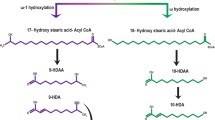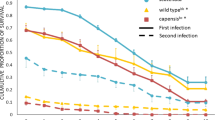Abstract
Honey bee colonies are characterised by well-developed reproductive division of labour between the queen and workers. Here, we test whether this reproductive division of labour is evident in both the socially parasitic workers that invade a colony as well as in their offspring generation. We infected six Apis mellifera scutellata host colonies with pseudo-clonal socially parasitic Cape honeybee workers (Apis mellifera capensis). We show that the first generation of socially parasitic workers can monopolize reproduction within host colonies. Of the initially invading parasites, 94.4% became reproductive pseudoqueens with activated ovaries and produced queen-like pheromones. Their offspring, however, had much lower levels of ovary activation (3.1%), yet 89% showed fatty acid synthesis typical of the queen substance (9-oxo-2(E)-decenoic acid) biochemical pathway. However, in these second-generation workers, the last oxidation step from the precursor (9-hydroxy-2(E)-decenoic acid) to the queen substance was interrupted and appears to be required for reproductive dominance in honeybee workers. Our data show that despite the absence of genetic diversity, residual queen mandibular pheromone (QMP) variation is sufficient to establish reproductive dominance hierarchies among parasitic workers. Consequently, QMP produced by a group of workers can maintain reproductive division of labour in queenless honeybee colonies.



Similar content being viewed by others
References
Allsopp, M.H., Crewe, R.M. (1993) The Cape honeybee as a Trojan horse rather than the hordes of Jenghiz Khan. Am. Bee J. 133, 121–123
Barbier, J., Lederer, E. (1960) Structure chimique de la substance royale de la reine d’abeille (Apis mellifera L.). C. R. Acad. Sci., Ser. 3 Sci Vie. 251, 1131–1135
Baudry, E., Kryger, P., Allsopp, M.H., Koeniger, N., Vautrin, D., Mougel, F., Cornuet, J.-M., Solignac, M. (2004) Whole-genome scan in thelytokous-laying workers of the Cape honeybee (A. m. capensis): central fusion, reduced recombination rates and centromere mapping using half tetrad analysis. Genetics 167, 243–252
Butler, C.G., Callow, R.K., Johnston, N.C. (1961) The isolation and synthesis of queen substance, 9-oxodec-trans-2-enoic acid, a honeybee pheromone. Proc. R. Soc. Lond., B Biol Sci. 155, 417–432
Crewe, R.M., Moritz, R.F.A. (1989) Variation in the components of head extracts of workers and queens of Apis mellifera intermissa Buttel-Reepen. Z. Naturforsch. 44, 590–596
Crewe, R.M., Velthuis, H.H.M. (1980) False queens: a consequence of mandibular gland signals in worker bees. Naturwissenschaften 65, 467–469
Dietemann, V., Pflugfelder, J., Härtel, S., Neumann, P., Crewe, R.M. (2006) Social parasitism by honeybee workers (Apis mellifera capensis Esch.): evidence for pheromonal resistance to host queens signals. Behav. Ecol. Sociobiol. 60, 785–793
Dietemann, V., Neumann, P., Härtel, S., Pirk, C.W.W., Crewe, R.M. (2007) Pheromonal dominance and the selection of a socially parasitic honeybee worker lineage (Apis mellifera capensis Esch.). J. Evol. Biol. 20, 997–1007
Dor, R., Katzav-Gozansky, T., Hefetz, A. (2005) Dufour’s gland pheromone as a reliable fertility signal among honeybee (Apis mellifera) workers. Behav. Ecol. Sociobiol. 58, 270–276
Estoup, A., Solignac, M., Cornuet, J. (1994) Precise assessment of the number of patrilines and of genetic relatedness in honeybee colonies. Proc. R. Soc. Lond., B Biol Sci. 258, 1–7
Gehrke, C.W., Leimer, K. (1971) Trimethylsilylation of amino acids. Derivatization and chromatography. J. Chromatography 57, 219–238
Greeff, J.M. (1997) The Cape honeybee and her way north: an evolutionary perspective. S. Afr. J. Sci. 93, 306–308
Härtel, S., Neumann, P., Raasen, F.S., Moritz, R.F.A., Hepburn, H.R. (2006a) Social parasitism by Cape honeybee workers in colonies of their own subspecies (Apis mellifera capensis Esch.). Insect. Soc. 53, 183–193
Härtel, S., Neumann, P., Kryger, P., von der Heide, C., Moltzer, G.-J., Crewe, R.M., van Praagh, J.P., Moritz, R.F.A. (2006b) Infestation levels of Apis mellifera scutellata swarms by socially parasitic Cape honeybee workers (Apis mellifera capensis Esch.). Apidologie 37, 462–470
Hemmling, C., Koeniger, N., Ruttner, F. (1979) Quantitative Bestimmung der 9-Oxodecensäure im Lebenszyklus der Kaphonigbiene (Apis mellifera capensis Escholtz). Apidologie 10, 227–240
Hepburn, H.R. (1992) Pheromonal and ovarial development covary in Cape worker honeybees (Apis mellifera capensis). Naturwissenschaften 79, 523–524
Hepburn, H.R., Radloff, S.E. (1998) Honeybees of Africa. Springer, New York
Hoover, S.E.R., Keeling, C.I., Winston, M.L., Slessor, K.N. (2003) The effect of queen pheromones on worker honey bee ovary development. Naturwissenschaften 90, 477–480
Hoover, S.E.R., Keeling, C.I., Winston, M.L., Oldroyd, B.P. (2005) Retinue attraction and ovary activation: responses of wild type and anarchistic honey bees (Apis mellifera) to queen and brood pheromones. Behav. Ecol. Sociobiol. 59, 278–284
Katzav-Gozansky, T., Boulay, R., Soroker, V., Hefetz, A. (2006) Queen pheromones affecting the production of queen-like secretion in workers. J. Comp. Physiol. A 192, 737–742
Keeling, C.I., Slessor, K.N., Higo, H.A., Winston, M.L. (2003) New components of the honey bee (Apis mellifera L.) queen retinue pheromone. PNAS 100, 4486–4491
Lattorff, H.M.G., Moritz, R.F.A., Fuchs, S. (2005) A single locus determines thelytokous parthenogenesis of laying honeybee workers (Apis mellifera capensis). Heredity 94, 533–537
Lattorff, H.M.G., Moritz, R.F.A., Crewe, R.M., Solignac, M. (2007) Control of reproductive dominance by the thelytoky gene in honeybees. Biol. Letters 3, 292–295
Makert, G.R., Paxton, R.J., Hartfelder, K. (2006) Ovariole number—a predictor of differential reproductive success among worker subfamilies in queenless honeybee (Apis mellifera L.) colonies. Behav. Ecol. Sociobiol. 60, 815–825
Martin, S.J., Wossler, T.C., Kryger, P. (2002) Usurpation of African Apis mellifera scutellata colonies by parasitic Apis mellifera capensis workers. Apidologie 33, 215–232
Martin, C.G., Oldroyd, B.P., Beekman, M. (2004) Differential reproductive success among subfamilies in queenless honeybee (Apis mellifera L.) colonies. Behav. Ecol. Sociobiol. 56, 42–49
Moritz, R.F.A., Crewe, R.M. (2005) The interplay of intracolonial genotypic variance and self-organisation of dominance hierarchies in honeybees. In: Hemelrijk, C.K. (ed.) Self-Organisation and Evolution of Social Behaviour, pp. 36–49. Cambridge University Press, Cambridge
Moritz, R.F.A., Hillesheim, E. (1985) Inheritance of dominance in honeybees (Apis mellifera capensis). Behav. Ecol. Sociobiol. 17, 87–89
Moritz, R.F.A., Kryger, P., Allsopp, M.H. (1996) Competition for royalty in bees. Nature 384, 31
Moritz, R.F.A., Simon, U.E., Crewe, R.M. (2000) Pheromonal contest between honeybee workers. Naturwissenschaften 87, 395–397
Moritz, R.F.A., Pflugfelder, J., Crewe, R.M. (2003) Lethal fighting between honeybee queens and parasitic workers (Apis mellifera). Naturwissenschaften 90, 378–381
Moritz, R.F.A., Lattorff, H.M.G., Crewe, R.M. (2004) Honeybee workers (Apis mellifera capensis) compete for producing queen-like pheromone signals. Proc. R. Soc. Lond 271(Suppl.), S98–S100
Moritz, R.F.A., Härtel, S., Neumann, P. (2005a) Global invasions of the western honeybee (Apis mellifera L.) and the consequences for biodiversity. Écoscience 12, 289–301
Moritz, R.F.A., Lattorff, H.M.G., Neumann, P., Kraus, F.B., Radloff, S.E., Hepburn, H.R. (2005b) Rare royal families in honeybees, Apis mellifera. Naturwissenschaften 92, 488–491
Naumann, K., Winston, M.L., Slessor, K.N., Prestwich, G.D., Webster, F.X. (1991) Production and transmission of honey bee queen (Apis mellifera L.) mandibular gland pheromone. Behav. Ecol. Sociobiol. 29, 321–332
Neumann, P., Hepburn, H.R. (2002) Behavioural basis for social parasitism of Cape honeybees (Apis mellifera capensis Esch.). Apidologie 33, 165–192
Neumann, P., Härtel, S., Kryger, P., Crewe, R.M., Moritz, R.F.A. (2011) Reproductive division of labor and thelytoky result in sympatric barriers to gene flow in honeybees (Apis mellifera L.). J. Evol. Biol. 24, 286–294
Oldroyd, B.P., Fewell, J.H. (2007) Genetic diversity promotes homeostasis in insect colonies. Trends Ecol. Evol. 22, 408–413
Oldroyd, B.P., Smolenski, A.J., Cornuet, J.-M., Crozier, R.H. (1994) Anarchy in the beehive: a failure of worker policing in Apis mellifera. Nature 371, 479
Pain, J. (1961) Sur la phéromone des reines d’abeilles et ses effets physiologiques. Ann. Abeille. 4, 73–152
Pankiw, T., Winston, M.L., Fondrk, K.M., Slessor, K.N. (2000) Selection on worker honeybee responses to queen pheromone (Apis mellifera L.). Naturwissenschaften 87, 487–490
Pearcy, M., Hardy, O., Aron, S. (2006) Thelytokous parthenogenesis and its consequences on inbreeding in an ant. Heredity 96, 377–382
Plettner, E., Slessor, K.N., Winston, M.L., Robinson, G.E., Page, R.E. (1993) Mandibular gland components and ovarian development as measures of caste differentiation in the honey bee (Apis mellifera L.). J. Insect Physiol 39, 235–240
Plettner, E., Slessor, K.N., Winston, M.L., Oliver, J.E. (1996) Caste-selective pheromone biosynthesis in honeybees. Science 271, 1851–1853
Plettner, E., Slessor, K.N., Winston, M.L. (1998) Biosynthesis of mandibular acids in honey bees (Apis mellifera). De novo synthesis, route of fatty acid hydroxylation and caste-selective b-oxidation. Insect Biochem. and Mol. Biol. 28, 31–42
Ratnieks, F.L.W., Visscher, P.K. (1989) Worker policing in the honeybee. Nature 342, 796–797
Ruttner, F., Hesse, B. (1981) Rassenspezifische Unterschiede in Ovarentwicklung und Eiablage von weisellosen Arbeiterinnen der Honigbiene Apis mellifera L. Apidologie 12, 159–183
Schäfer, M.O., Dietemann, V., Pirk, C.W.W., Neumann, P., Crewe, R.M., Hepburn, H.R., Tautz, J., Crailsheim, K. (2006) Individual versus social pathway to honeybee worker reproduction (Apis mellifera): pollen or jelly as protein source for oogenesis? J. Comp. Physiol. A 192, 761–768
Simon, U., Moritz, R.F.A., Crewe, R.M. (2005) Reproductive dominance among honeybee workers in experimental groups of Apis mellifera capensis. Apidologie 36, 413–419
Slessor, K.N., Foster, L.J., Winston, M.L. (1988) Royal flavours: honey bee queen pheromones. In: Van der Meer, R.K., Breed, M.D., Winston, M.L., Espelie, K.E. (eds.) Pheromone Communication in Social Insects, pp. 331–343. Westview, Boulder
Slessor, K.N., Winston, M.L., Le Conte, Y. (2005) Pheromone Communication in the Honeybee (Apis mellifera L.). J. Chem. Ecol. 31, 2731–2745
Swart J.D. (2003) The occurrence of Nosema apis (Zander), Acarapis woodi (Rennie), and the Cape honeybee problem in the summer rainfall region of South Africa. M.Sc. thesis, Rhodes University, Grahamstown, South Africa, pp 67
Velthuis, H.H.W. (1970) Ovarian development in Apis mellifera worker bees. Entomol. Exp. Appl. 13, 377–394
Velthuis, H.H.W., Ruttner, F., Crewe, R.M. (1990) Differentiation in reproductive physiology and behaviour during the development of laying worker honeybees. In: Engels, W. (ed.) Social Insects, pp. 231–243. Springer, Berlin
Verma, S., Ruttner, F. (1983) Cytological analysis of the thelytokous parthenogenesis in the Cape honeybee (Apis mellifera capensis Escholtz). Apidologie 14, 41–57
Wilson, E.O. (1971) The Insect Societies. Harvard University Press, Cambridge
Winston, M.L., Slessor, K.N. (1992) The essence of royalty: honey bee queen pheromone. Am. Sci. 80, 374–385
Winston, M.L., Slessor, K.N., Willis, L.G., Naumann, K., Higo, H.A., Wyborn, M.H., Kaminski, L.A. (1989) The influence of queen mandibular pheromones on worker attraction to swarm clusters and inhibition of queen rearing in the honey bee (Apis mellifera L.). Insect. Soc. 36, 15–27
Wossler, T.C. (2002) Pheromone mimicry by Apis mellifera capensis social parasites leads to reproductive anarchy in host A. m. scutellata colonies. Apidologie 33, 139–163
Acknowledgements
We are grateful to Petra Leibe for technical assistance. Financial support was granted by an Emmy Noether fellowship of the DFG (PN), a post-doctoral fellowship of the University of Pretoria (TCW), the VW foundation (RFAM and RMC) and the National Research Foundation of South Africa (RMC). We thank H. Randall Hepburn and an anonymous referee for helpful comments on an earlier version of the manuscript.
Orientation phéromonale de la hiérarchie de dominance reproductive chez les abeilles ouvrières pseudo-clonales ( A. mellifera capensis ).
abeille du Cap / phéromone mandibulaire / reine / seuil de réponse / reproduction des ouvrières / division du travail
Pheromon vermittelte reproduktive Dominanzhierarchien zwischen pseudo-klonalen Arbeiterinnen der Kaphonigbiene.
Kaphonigbiene / Selbstorganisation / Königinnen Mandibelpheromon / Resonanz-Schwellenwert / Reproduktive Arbeitsteilung / Arbeiterinnen Reproduktion
Author information
Authors and Affiliations
Corresponding author
Additional information
Manuscript editor: Bernd Grünewald
Rights and permissions
About this article
Cite this article
Härtel, S., Wossler, T.C., Moltzer, GJ. et al. Pheromone-mediated reproductive dominance hierarchies among pseudo-clonal honeybee workers (Apis mellifera capensis). Apidologie 42, 659–668 (2011). https://doi.org/10.1007/s13592-011-0066-0
Received:
Revised:
Accepted:
Published:
Issue Date:
DOI: https://doi.org/10.1007/s13592-011-0066-0




